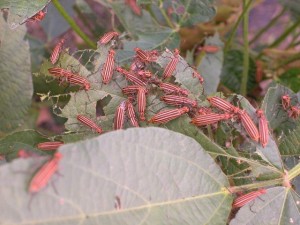
Soybean – There have been few calls on soybean. Stink bug populations are low with a few exceptions. However, I’ve definitely seen an upturn of green stink bug adults in early maturing soybean. No significant infestations of corn earworm or other caterpillar pests have been reported. With some of the recent rains, insect pressure may pick up. I’ve had a few calls on blister beetles, primarily the striped blister beetle. Seeing a few small spots of blister beetles in soybean fields is not uncommon, and there can be a lot of defoliation in these isolated spots. My recommendation is to watch these spots closely and treat only if they get larger or more hot spots show up. It is common for blister beetles to disappear as quickly as they started. Of course, treat anytime if infestations are causing average defoliation more than 30-35% defoliation in pre-flowering soybean or 20-25% defoliation in flowering soybean. Synthetic pyrethroids provide excellent control.
Cotton – Reports are of light stink bug infestations, and plant bug infestations are sporadic and mostly occurring in river bottoms and in the “better” cotton. Expect pressure to intensify where recent rains have perked up the crop. The bollworm flight will likley kick off this week, but indications are that it will not be a big flight (despite all the corn acres). Spider mites are still generating most of the phone calls. On the upside, some folks are reporting populations are on the decline. The rain and humidity (associated with an epizootic fungus) and predators (especially western flower thrips) are helping us out in some cases.
- Although there is value is doing both drop cloth and sweep net samples in blooming cotton, I typically recommend concentrating on drop cloth sampling once cotton has been blooming for 7-10 days. It is a better tool for monitoring immatures, which often compose the majority of the population in blooming cotton. The suggested treatment threshold is an average of 3 or more tarnished plant bugs per drop cloth. A good rule of thumb is to count stink bugs as equivalent to 3 tarnished plant bugs when making treatment decisions.
- I also suggest switching off the neonicotinoid insecticides such as Centric or imidacloprid at this time. Give them a rest for at least 2-3 weeks to help manage resistance. Frankly, imidacloprid is not a tier one product for plant bugs in mid or late season.
- Expect bollworms to begin showing up next week. I don’t expect a large flight, but they will likely be in the mix. Treatment is recommended if an average of 4 or more larvae are found per 100 plants. In Bt cotton, I normally suggest ignoring tiny, freshly hatched larvae; letting the Bt technologies do their thing. However, use common sense. Finding 20% of plants infested with tiny larvae (or egg lays exceeding 30-40%) would definitely influence my treatment decision.

